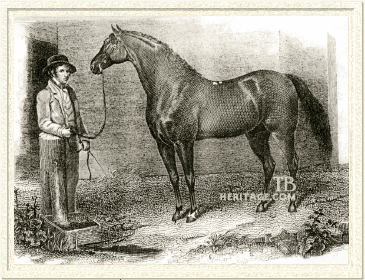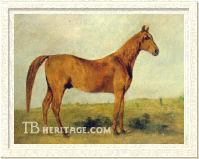|
|
Duroc

|
|
 |
|
|
Duroc's fame rests primarily on the laurels of his famous son, American Eclipse. Still, like other Diomed sons, he was a very good race horse, when not exploiting the weakness of his jockeys, and from limited opportunities to breed thoroughbred mares, sired some good winners in early nineteenth century America.
Duroc was bred by Wade Mosby in Powhatan County, Virginia. His sire, Epsom Derby winner Diomed, was one of the most influential stallions ever imported into the U.S., since it was through his son, Sir Archy, that the great Lexington descended. But Diomed's influence went much further, with scarcely a good horse bred in early nineteenth century America that did not have Diomed in its pedigree.
Duroc's dam, Amanda, was by Tayloe's Grey Diomed, a son of Medley, the latter another important sire in post-Revolutionary America. Grey Diomed (1786) was a top racehorse in the U.S., of great stamina, who won a number of races, including a four mile match at Bowling Green, beating a famous race mare, Isabella; a jockey club purse at Bowling Green and one at Petersburg; and a jockey club purse in four-mile heats at Bowling Green. He beat another famous horse of the day, Cincinnatus, twice in one month, first in a jockey club purse, four-mile heats, at Chestertown, Maryland, and then a jockey club purse at Annapolis, also beating some other good horses. His career virtually ended when he fell at Alexandria, Virginia, in December of 1794, and he was sold by his owner, Colonel Tayloe, in 1798 to J. Blick for $2,200.
Amanda (1800) was bred by John Broaddus, a neighbor of Colonel John Hoomes of Virginia,who sold her for Broaddus to Mosby for $300 at the Richmond (Virginia) races in 1804. She showed a great deal of promise in her trials against Mosby's other runners, and in her debut, a one mile race against some fast horses at Powhatan Court house, she won by over 100 yards. She went on to win an important four mile race in two heats at Broadrock, Virginia, beating Whiskey and others, but came up sore on the hard ground and was withdrawn from her next race at Fredericksburg. In her next outing, a sweepstakes at Richmond, she was beaten by Top Gallant, but came in ahead of another good mare, Lavinia. She pulled a tendon in her last race, a stakes at Richmond, and was retired to the stud. She was put to Diomed in the spring of 1805, and the following year threw Duroc, her first and only foal; a few days prior to her due date for her second foal, by Knowsley, she was kicked by a horse, which caused the death of her and the foal she was carrying.
Duroc was a substantial chestnut colt, and grew to be a muscular, heavily-boned animal standing 15.3 hands. He was also a temperamental horse.
Duroc ran several times in Virginia, one a grueling five-heat four mile race at Fairfield, where he dead-heated with Sir Alfred in the first two heats, and then was withdrawn. He was then was sold by his breeder in 1810 to Bela Badger, of Bristol Pennsylvania, for $2,500, and in the fall of his four year old year he won a big four mile match race against another good Diomed son, Hampton, at the Fairview course in Pennsylvania, setting a course record of seven minutes and 53 seconds. In his next match with Hampton, Duroc bolted, and lost the race.
|

His son, American Eclipse | |
Sold in 1813 to New Yorker Townsend Cock, of Oyster Bay, Long Island, he was bred to fifty mares, and then put back in training. In the fall of that year he won a race at the New Market course in four mile heats, beating Pegassus and Volunteer. The next spring, after his stud duties were done for the season, he was matched against Defiance, and "it was thought Duroc would have won, but for a vicious habit he had got into, having been ridden by a boy that could not manage him, which caused him to bolt at his will, without any apparent cause." It was his last race. |
He was sold again to Mr. Kelsey of Hyde Park, Long Island, for $2,000, and died in his keeping, after a sudden illness, in 1825, age 19.
Isolated in New York, far from the more active breeding centers further south, he had limited opportunity to breed to thoroughbred mares. When he did meet them, he produced such good runners as the fast Romp (1815) and the good four-miler Cock of the Rock (1814), both out of a Messenger daughter, Old Romp; Marshal Duroc (1812), a fast horse with great stamina; Trouble, that could win at any distance, and Sir Lovell, another good race horse. Duroc's grandson, American Star (1822) had an influence on the development of the Standardbred breed. Duroc is known, however, as the sire of American Eclipse, out of another Messenger daughter, Miller's Damsel; he was one of the top racehorses of his day and got a good sire son, Medoc, and some top running daughters, and daughters who had an influence on American bloodlines.
-- Patricia Erigero
|
|
|
|

